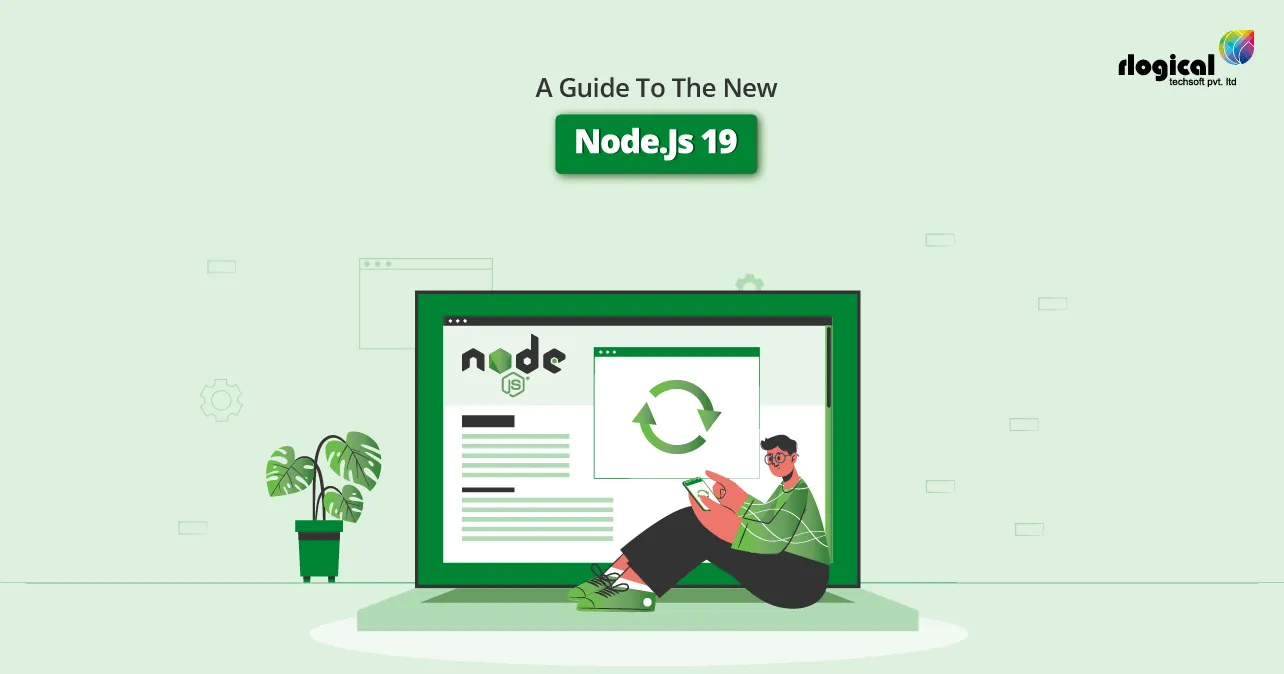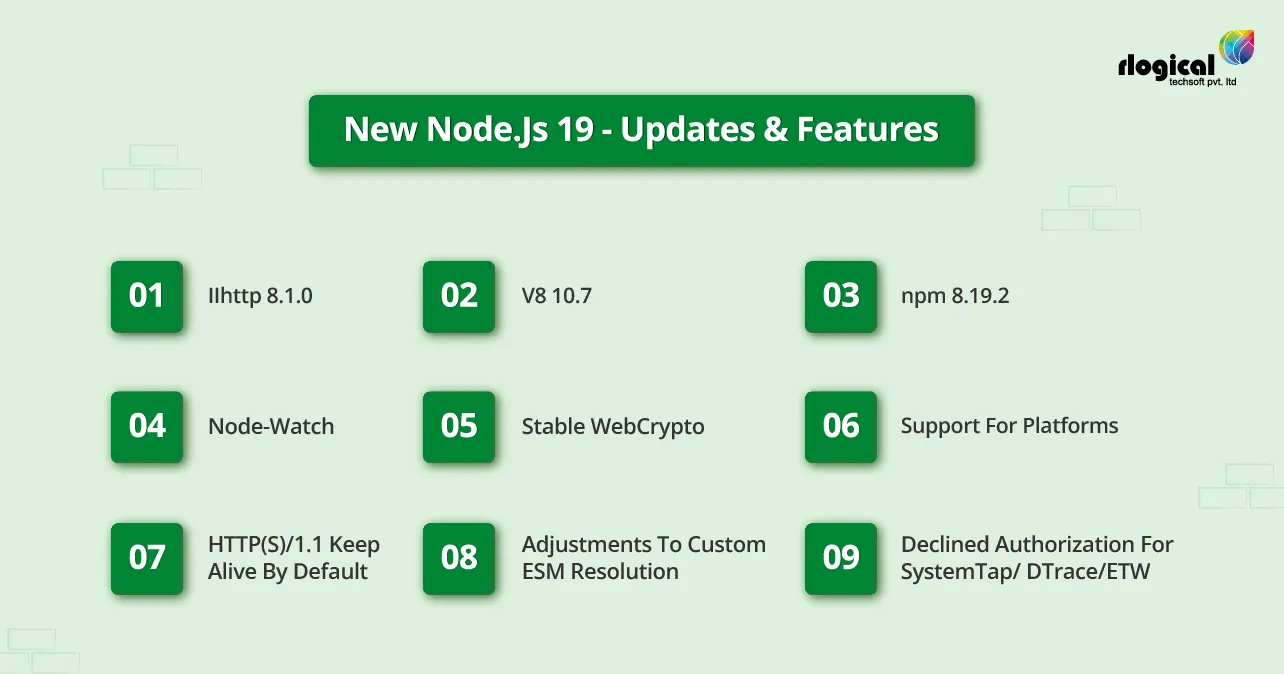
October signifies the end of summer in most parts of the globe. It is one of the important months for the developers as a new Node.js release and an LTS version upgrade to Node.Js 18 is made. The Node.Js community released its new Node.js 19 on the 25th of October and gave an upgrade to its Node.js 18, an LTS or Long-term support version. This month, when Node.js 18 enters LTS, Node.js 19 will become their “Current” release line.
According to the plan, Node.js 19 is the “Current” release for the next six months until April 2023. The fact that new releases of Node.js 19 are available approximately every two weeks keeps you updated on the most recent enhancements and features. Due to the improved frequency of Node.js releases, cool segments are now included over time, but Node.js 19 encloses various updates.
What’s New In Node.Js 19?
Since the previous release, there have been over one thousand and one hundred fifty commits, so much toil went into Node.js 19. This time, the number of headline features is limited because much of the toil was done behind the backgrounds, fixing or refactoring existing features. The Node.js crew has released Node.js 19, which automatically activates HTTP(s)/1.1 KeepAlive and brings the JavaScript engine V8 up to version 10.7.
The most recent version of Intl has been added to the JavaScript API in version 10.7 of the V8 JavaScript engine. NumberFormat enables programmers to create a formatted instance that supports locale-aware number formatting and is reusable. Any outgoing connection with HTTP(s)/1.1 KeepAlive enabled by default will use it automatically, resulting in improved throughput. This is due to the reuse of connections. Let us now know more information about these features.
What Are The Updates And Features Of The New Node.Js 19?

1. HTTP(S)/1.1 KeepAlive By Default
KeepAlive is set to true by default in Node.js, starting with this release of HTTP(S)/1.1. As a result, HTTP 1.1 Keep-Alive will be used by every outgoing HTTP connection. The waiting period is five seconds by default. Since connections are reused by default, enabling keep-alive will result in improved throughput. Additionally, the agent can now parse the Keep-Alive response sent by the servers. The client is told how much to stay connected by this header.
In contrast, when close() is called, the Node.js 19 HTTP server will automatically disjoin inactive clients utilizing Keep-Alive HTTP to reuse the connection. By default, Node.js HTTP(S)/1.1 requests may have better throughput and performance. By default, this means improved performance and throughput.
2. Node-Watch
The experimental “–watch” command line option in Node.js 19 is great news if you have used nodemon to speed up your development process. With this feature, Node.js is put into watch mode and restarts itself whenever files are updated. Remember that it can only be used on Windows and macOS, the most widely used development platforms.
3. Stable WebCrypto
The WebCrypto is now stable in the Node.js 19 version. However, it has some exceptions in X25519, Ed448, Ed25519, and X448 algorithms.
To access this module, you can use require(‘node:crypto’).webcrypto or globalThis.crypto.
4. Adjustments To Custom ESM Resolution
Node.js no longer supports the –experimental-specifier-resolution option. Custom loaders are now available for achieving its functionality.
5. Declined Authorization For SystemTap/ DTrace/ETW
DTrace can be employed to get a worldwide synopsis of a running procedure, including the amount of memory, filesystem, CPU time, and network resources used by the active processes. SystemTap and ETW support has been removed. It can be a useful tool, but prioritizing resources makes it hard to keep it updated. Without a clear strategy for supporting these tools, the complexity of maintaining the support has proven to be inconvenient.
6. V8 10.7
Node.js 19 includes the V8 JavaScript engine in version 10.7. This improves performance while also keeping Node.js up to date with JavaScript features. The V8 JavaScript engine is the runtime environment that runs JavaScript code. This allows JavaScript to run on various platforms, so developers don’t have to worry about whether their code runs on Windows, Linux, macOS, Arm, x64, or Power PC hardware. V8, on the other hand, is written in C++ and depends on the Node community to be maintained and improved for various hardware and operating system combinations. As new features are added to Node.js Development, seeing that effort bears fruit is satisfying.
7. npm 8.19.2
Although the version of npm included in the Node.js 18 line is the same version that will be included in Node.js 19, it started with version 8.6.0, so new versions keep us up to date on the npm front.
8. IIhttp 8.1.0
This project is a TypeScript port of http_parser. The output C source file, which can be compiled and linked with an embedded program like Node.js, is generated using this method. It breaks down both responses and requests. The parser is intended for use in HTTP applications that require high performance. IIhttp is regularly enhanced by the Node.js Development Team with new callbacks and API features.
9. Support For Platforms
Unlike the previous version, Node.js 19 does not significantly change the supported platforms. The base requirements in BUILDING.md have not changed, but any operating systems that have gone EOL will no longer be supported.
Conclusion
When there are major releases, it’s a good time to look at the project’s progress rather than just the release’s content. As a result of the project’s approach to features, numerous features are backported into previously released release lines and are not “new” in a major release. Users will appreciate the quick access to new features provided by this. In addition to the V8 JavaScript engine 10.7 feature, Node.js 19 includes several new features and enhancements, including the experimental node watch mode and HTTP(S)/1.1 KeepAlive by default. Until node.js 20 is released, this is the current version.
Rafael Gonzaga, a member of the Node.js Core, stated-
Since its most recent release, Node.js has received over 1,150 commits, and its functionality continues to evolve.Node.js 19 significantly enhances connectivity, performance, and throughput. We have put a lot of effort into making Node.js more secure and efficient, and I think we are getting better.Node.js 18 LTS is ideal for active deployment. “Node.js 19 is ready if you want to access features early.”
Rahul Panchal
Rahul Panchal is the Founder & Managing Director at Rlogical Techsoft Pvt. Ltd. He is a pioneer tech enthusiast who has assisted diverse enterprise solutions with a fresh perspective over the years. From integrating technologies like Full-Stack, .NET, Flutter & PHP, he has harnessed custom web or hybrid mobile app development projects. His creative outlook on the latest models of AI, ML, blockchain, and IoT, has made various businesses attain leading-edge success.
Related Blog
Categories
- All
- Amazon Web Services (AWS)
- ASP.Net Development
- Azure Web App
- Big Data Analytic
- Customize
- Digital Marketing
- Drupal Development
- E-commerce web development
- Education Mobile App Development
- Enterprise Application
- Event Management App Development
- Fintech
- Fitness App Development
- Food Delievery
- Front-End Development
- Healthcare App Development
- Hire Dedicated Developers
- Hotel Booking App
- IT Industry
- JavaScript Development
- Mobile App Development
- On Demand App Development
- On Demand Healthcare App Development
- PHP Development
- POS Software Development
- Real Estate Mobile App Development
- Retail Business App Development
- Salesforce
- Social Media Development
- Software Development
- Technology
- Transportation App Development
- UI/UX Design
- Web Design
- Web Development
- Web Services
- Web/Data Scraping Services
- WordPress



 Rahul Panchal in NodeJS
Rahul Panchal in NodeJS 





